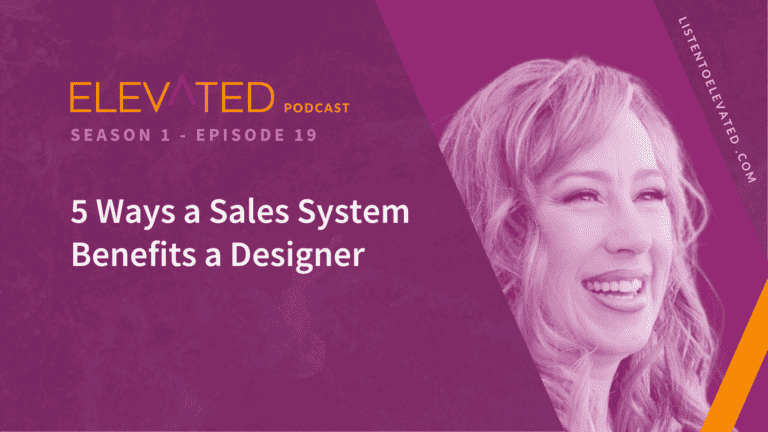5 Ways a Sales System Benefits a Designer

Over our past few episodes, we’ve covered various aspects of sales systems, exploring how they can enhance client experiences, streamline processes, and boost efficiency. In this episode we are breaking down how sales systems can be tailored to serve the unique needs of designers. We’ve already discussed why designers need sales systems in a previous episode. Now we’ll get into the practical ‘how-to.’
The Rewards of Proper Sales System Onboarding
The challenge with sales systems and utilizing the tools that power the systems is that they often do a lot, which can be overwhelming and make it hard to find time for onboarding and learning. However, proper onboarding can pay big dividends because many of these features only need to be set up once, and then they can be utilized daily to save significant time and effort. The whole point of having the system, paying for the tool, and investing time is to achieve these dividends; allowing the designer to spend just 15-30 minutes a day on sales and the rest of their time on designs. Isn’t that the dream? This becomes a possibility when you properly set up all these pieces.
Enhancing Sales Process Effectiveness
So, let’s discuss the key functionalities that can supercharge sales process effectiveness. These core elements include Lists, Reminders, Views, Templates, and the magic of Scheduling Emails.
1. Lists:
Lists are, in essence, a way to compartmentalize your data. They enable you to filter and view specific types of information tailored to what you need in the moment. If you’re managing active deals, for instance, you can have a list dedicated solely to these, providing a clear overview without distractions. Similarly, if you have strategic partners, such as interior designers or builders, each member of your sales team can have a list that pertains to their unique relationships, helping them focus their sales time. In a nutshell, Lists help you cut through the clutter and focus on only the information that matters.
2. Views:
Views allow you to filter information based on your specific needs at any given moment. Let’s say you’re in prospecting mode—your goal is to uncover new deals. With Views, you can set up a customized view that displays only the new leads that have recently come in. When you switch to follow-up mode, another view can show you leads who haven’t been contacted in the last two weeks. The flexibility of Views enables you to tailor the information in your sales system to your current objectives, ensuring you work smarter, not harder.
3. Reminders:
Reminders are an indispensable asset for staying on top of interactions and follow-ups. We’re all human, juggling numerous tasks and responsibilities. Reminders come to the rescue, ensuring you don’t forget crucial touchpoints. For example, after each phone call, set a reminder to follow up in a week. With the right reminders, you can stay on track with your interactions, keeping relationships warm and connections strong. Additionally, recurring reminders can be set up for periodic check-ins with your clients or partners, ensuring that you are regularly staying in-touch.
4. Templates:
When we talk about templates, we’re primarily referring to email message templates. Using templates streamlines communications by providing a starting point for your messages, allowing you to to spend your time & energy on adding personal touches. Templates can be particularly handy for standard communications, such as scheduling meetings, delivering designs, or sharing important updates. Using templates ensures consistency in your interactions while leaving room for personalization.
Moreover, templates can be a collaborative effort within your team. They offer a straightforward way to update messaging as your processes evolve. For example, if your project delivery process changes, you can update the corresponding templates, ensuring that every team member has access to the latest information and messaging. This not only saves time but also ensures that no one has to remember to change the information in the next email.
5. Scheduling Emails:
And finally, one of the most powerful things, which doesn’t even require a sales system at this point if you’re using Gmail or Outlook, is to schedule emails.
The Strategic Advantage of Scheduling Your Emails
I’ll try not to spend too long on my soapbox here. Scheduling emails is so powerful because it allows us to compose messages when it’s convenient for us, and it allows our recipients to receive messages when it makes sense for them. It doesn’t matter to me if you’re writing emails at 11 o’clock at night, but please, never send emails at 11 o’clock at night; it sends all the wrong messages, all the wrong signals, and causes confusion. Write the email anytime you want and schedule it to send; you can even schedule things to send a couple of days out.
So, if you’re using scheduling links, your prospects are getting reminders about meetings, your clients are getting reminders about meetings. But you can also schedule emails to go out after the meeting, so they get the follow-up they were expecting, or you delivered on the promise you made, or they’re getting the next step they needed.
Not only do these system features contribute to improved efficiency, effectiveness, and profitability, but they also play a significant role in enhancing overall satisfaction. After all, who wants to spend excessive time on tedious sales tasks, manual data entry, or repetitive follow-ups? These features make running your design business not only more profitable but also more enjoyable.
In the next episode you’ll learn about the most under-appreciated and largely overlooked aspect of a sales system – your email signature. Tune in to find out how to harness the power of your sign-off.

